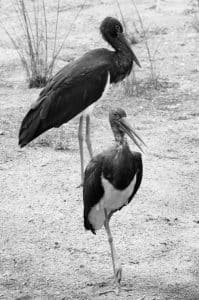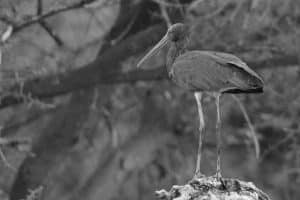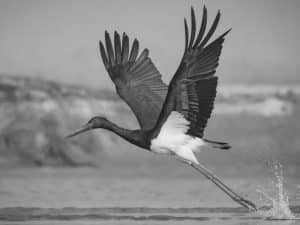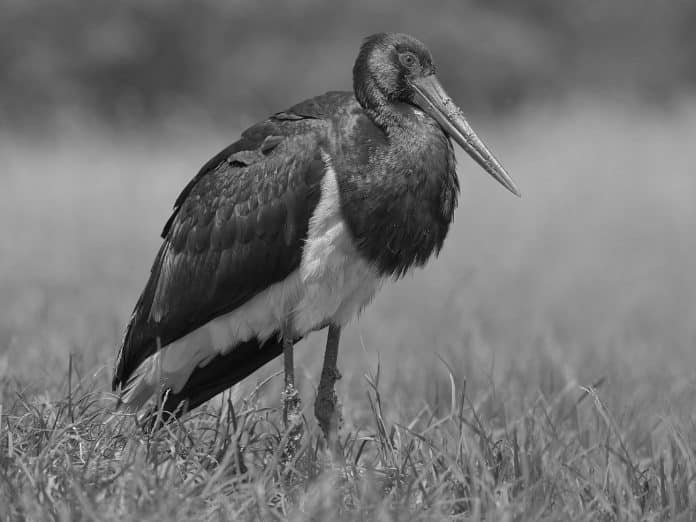Introduction to the Black Stork in Tanzania
The Black Stork is a majestic bird that calls Tanzania’s wetlands home. With its striking black plumage and regal appearance, it is a sight to behold. This article will delve into the habitat, distribution, physical characteristics, and behavior of the Black Stork in Tanzania. We will also discuss the conservation status of this magnificent bird and the threats it faces. Furthermore, we will explore the importance of African wetlands for the Black Stork in Tanzania and its role in the ecosystem. If you’re an avid birdwatcher or nature enthusiast, we’ll also provide you with tips on spotting and photographing Black Storks in the wild. Finally, we’ll highlight organizations and initiatives working towards Black Stork conservation in Tanzania, emphasizing the need to protect the future of these avian residents of African wetlands.
Habitat and Distribution of the Black Stork in Tanzania

The Black Stork is primarily found in wetland habitats throughout Tanzania. These wetlands include marshes, swamps, and riverbanks, providing the perfect environment for the bird to thrive. Tanzania’s diverse landscape, consisting of highlands, savannahs, and lakes, offers an abundance of wetland habitats that attract the Black Stork. These wetlands not only provide a rich food source but also serve as nesting sites for the bird.
The distribution of the Black Stork in Tanzania is widespread, with sightings reported across the country. However, certain regions are known to be hotspots for these avian residents. The Selous Game Reserve, located in southern Tanzania, is one such area. With its vast wetlands and diverse wildlife, the reserve offers an ideal habitat for the Black Stork. Other popular locations for Black Stork sightings include Lake Manyara National Park, the Serengeti National Park, and the Mahale Mountains National Park.
Physical Characteristics and Behavior of the Black Stork
The Black Stork is a large bird, measuring around 95-100 centimeters in length and weighing up to 4 kilograms. Its most distinguishing feature is its glossy black plumage, which covers its entire body except for its white belly and underwing coverts. The long, pointed bill of the Black Stork is yellowish-red, and its legs are a vibrant shade of red.
In terms of behavior, the Black Stork is known for its graceful flight and deliberate movements. It often feeds by standing still in shallow water, patiently waiting for prey to come within striking distance. The bird primarily feeds on fish, amphibians, crustaceans, and insects. During the breeding season, it constructs large nests made of sticks and vegetation in tall trees near water sources. The Black Stork is also known for its distinctive vocalizations, which include a low croaking sound and a series of loud clattering notes.
Conservation Status and Threats to the Black Stork Population

The Black Stork is currently classified as a species of Least Concern on the IUCN Red List. However, this does not mean that it is without threats. Like many bird species, the Black Stork faces various challenges that impact its population. One of the primary threats is habitat loss due to human activities such as agriculture, deforestation, and infrastructure development. The destruction of wetlands for these purposes reduces the available habitat for the Black Stork and disrupts its breeding and foraging patterns.
Another significant threat to the Black Stork is pollution, particularly water pollution caused by industrial activities and agricultural runoff. Polluted water bodies negatively affect the availability of prey for the bird and can lead to declines in population numbers. Additionally, climate change poses a threat to the Black Stork’s habitat, as rising temperatures and altered rainfall patterns can impact wetland ecosystems.
Importance of African Wetlands for the Black Stork
African wetlands play a crucial role in the survival of the Black Stork. These wetlands provide the bird with abundant food resources, including fish, frogs, and insects. The wetland vegetation also offers nesting sites and shelter for the Black Stork and its offspring. Furthermore, wetlands act as vital stopover points during the bird’s migration, providing resting and feeding areas along its journey.
Beyond the immediate benefits to the Black Stork, African wetlands are essential for maintaining overall ecosystem health. Wetlands act as natural filters, purifying water and improving its quality. They also help regulate water flow, preventing floods and droughts. Additionally, wetlands support a diverse range of plant and animal species, contributing to overall biodiversity.
The Role of the Black Stork in the Ecosystem
The Black Stork plays a significant role in the ecosystem of Tanzania’s wetlands. As a top predator, it helps regulate the population of fish, frogs, and insects, maintaining a healthy balance within the ecosystem. By controlling the numbers of these prey species, the Black Stork indirectly influences the abundance and behavior of other species in the wetland habitat.
Furthermore, the Black Stork contributes to nutrient cycling in wetland ecosystems. Its excrement, rich in organic matter, fertilizes the surrounding vegetation, promoting plant growth and providing food for other organisms. The nesting sites created by the Black Stork also serve as habitats for other bird species, further enhancing the biodiversity of the wetlands.
Popular Locations for Black Stork Sightings in Tanzania

If you’re eager to catch a glimpse of the magnificent Black Stork in Tanzania, there are several popular locations where sightings are more likely. The Selous Game Reserve, with its extensive wetlands and diverse wildlife, offers excellent opportunities for observing these birds in their natural habitat. Lake Manyara National Park, known for its flamingos and tree-climbing lions, is another hotspot for Black Stork sightings.
For those venturing to the Serengeti National Park, keep an eye out for Black Storks near rivers and lakes, particularly during the dry season when water sources are more concentrated. The Mahale Mountains National Park, located on the shores of Lake Tanganyika, is also a fantastic location for Black Stork sightings, with the added bonus of breathtaking mountain scenery.
Tips for Spotting and Photographing Black Storks in the Wild
Spotting and photographing Black Storks in the wild can be a rewarding experience for nature enthusiasts and photographers alike. Here are some tips to increase your chances of success:
- Research: Familiarize yourself with the habitat preferences and behavior of the Black Stork. This will help you identify suitable locations and understand their movement patterns.
- Timing: Plan your visit during the dry season when water sources are more concentrated. Black Storks are more likely to gather near these areas, making sightings easier.
- Patience and Observation: Find a comfortable spot near a water source and observe quietly. Black Storks are cautious birds and may take some time to approach. Avoid sudden movements or loud noises that could scare them away.
- Optical Equipment: Bring binoculars or a telephoto lens to get a closer look at the Black Storks. This will allow you to observe their behavior without disturbing them.
- Photography Etiquette: Respect the birds and their natural behavior. Maintain a safe distance to avoid causing stress or disrupting their activities. Capture the beauty of the Black Stork through your lens while minimizing any disturbance.
Organizations and Initiatives Working Towards Black Stork Conservation in Tanzania
Several organizations and initiatives are dedicated to the conservation of the Black Stork in Tanzania. These include:
- BirdLife International: BirdLife International works to protect birds and their habitats worldwide. In Tanzania, they collaborate with local communities and organizations to conserve wetlands and raise awareness about the importance of the Black Stork.
- Tanzania Forest Conservation Group: This organization focuses on forest conservation in Tanzania, including wetland habitats. They work to promote sustainable practices and protect the habitat of the Black Stork.
- Wildlife Conservation Society (WCS): WCS conducts research and conservation efforts in Tanzania, including the protection of wetland ecosystems. They work closely with local communities and government authorities to safeguard the Black Stork and its habitat.
Conclusion: Protecting the Future of the Black Stork in Tanzania’s Wetlands
The Black Stork is a regal avian resident of African wetlands, and Tanzania provides a vital habitat for this magnificent bird. However, the Black Stork faces threats from habitat loss, pollution, and climate change. It is crucial that we take action to protect the future of this species and ensure the preservation of the wetlands they rely on.
By understanding the habitat, behavior, and conservation status of the Black Stork, we can appreciate its importance in the ecosystem and work towards its conservation. Whether through supporting organizations and initiatives, promoting sustainable practices, or simply enjoying the beauty of these birds in their natural habitat, we all have a role to play in safeguarding the Black Stork in Tanzania’s wetlands. Let us come together to ensure a bright future for this regal avian resident of African wetlands.

































